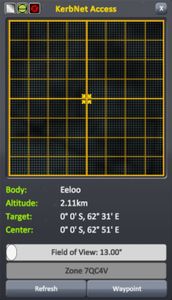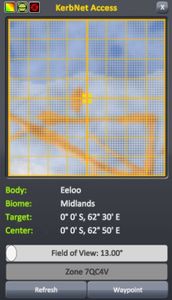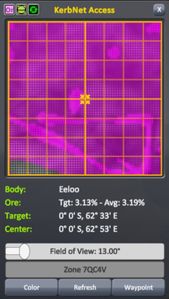Difference between revisions of "KerbNet"
m (Blanked the page) |
m (Reverted edits by Rocketing Rudolph (talk) to last revision by Bvoice360) |
||
| Line 1: | Line 1: | ||
| + | {{Stub}} | ||
| + | '''KerbNet''' is an orbital scanning and mapping system introduced in 1.2. When accessed from a KerbNet-capable part, a window will appear, displaying topographic, biome or resource maps for the area under the craft depending on the selected mode and the technical capabilities of the part. The information given in the lower half of the window will change dependent on the mode, and is for the area covered by the target reticule, which can be moved by clicking anywhere on the map. Below the information is the FOV slider (which adjusts the "cone of view"-essentially a zoom function at higher altitudes), the waypoint naming box and the buttons 'waypoint' (which places a waypoint under the reticule) and 'refresh' (which updates the map for when the vessel has moved). Along the top are four additional buttons-(from left to right) the button to toggle between modes, a button to toggle the gridlines and reticule, the button to change auto-update frequency and the exit button. | ||
| + | == Modes == | ||
| + | === Terrain === | ||
| + | [[File:KerbNet Terrain Mode.jpg|172x300px|thumbnail|left|Terrain Mode]] | ||
| + | |||
| + | |||
| + | |||
| + | |||
| + | |||
| + | |||
| + | |||
| + | |||
| + | Terrain Mode is the most basic of the three modes, displaying a simple monochrome elevation map of the surface directly under the craft-lighter areas are at a higher elevation, darker areas are lower. While not particularly useful on its own, Terrain Mode can be used to assess flat landing sites for craft, pick out areas at a high elevation for potential ΔV savings on subsequent takeoffs from atmospheric planets (notably [[Eve]]), place waypoints for future reference and scan for anomalies without the clutter of Biome Mode.{{clear|left}} | ||
| + | |||
| + | === Biome === | ||
| + | [[File:KerbNet Biome Mode.jpg|172x300px|thumbnail|left|Biome Mode]] | ||
| + | |||
| + | |||
| + | |||
| + | |||
| + | |||
| + | |||
| + | |||
| + | |||
| + | |||
| + | Biome Mode is significantly different from Terrain Mode in that it presents you with a false-colour map of the [[Biome|biomes]] under the craft. This provides information pertaining to which biomes you are passing over, greatly easing the task of conducting biome-specific [[Science#Activities|science experiments]] by informing you which biome you are currently over and which others are nearby or will be under the craft soon (assuming they are covered by the FOV) and highlighting where one ends and another begins (which is not always obvious).{{clear|left}} | ||
| + | |||
| + | === Resource === | ||
| + | [[File:KerbNet Ore Mode.jpg|172x300px|thumbnail|left|Resource Mode]] | ||
| + | |||
| + | |||
| + | |||
| + | |||
| + | |||
| + | |||
| + | |||
| + | |||
| + | |||
| + | Resource Mode (also known as Ore Mode) is a special function unique to the [[M4435 Narrow-Band Scanner]]. It displays the relative resource ([[Ore|ore]]) concentrations in a fashion similar to that of Biome Mode except that each biome is instead shaded according to its ore concentration. By default, a higher ore concentration is signified by a darker shade of purple, though there are three other colour schemes available-(brighter green=more ore), (green=low, yellow=medium low, orange=medium high, red=high) and (blue=low, pink=medium low, purple=medium high, red=high). This mode is useful for telling where to maximise the efficiency of mining operations by landing them in places with the most ore, sometimes in conjunction with the [[Surface Scanning Module]].{{clear|left}} | ||
| + | |||
| + | == Anomaly Detection == | ||
| + | An additional feature of most KerbNet modules is the ability to detect anomalies (marked as a "?" on the map). Features marked as 'anomalies' can be [[List_of_easter_eggs|easter eggs]], monoliths or even the Space Program's own [[CommNet|DSN]] groundstations. The detection rate for these anomalies is dependent on the 'anomaly detection' stat for each module-for example, the [[Probodobodyne RoveMate]] will always immediately detect nearby anomalies while the [[M4435 Narrow-Band Scanner]] cannot detect them at all. | ||
| + | |||
| + | == List of KerbNet Modules == | ||
| + | There are a total of twelve KerbNet-capable parts, including all ten unmanned command modules. All of these modules require a [[CommNet]] link to Kerbin in order to be able to use KerbNet. | ||
| + | |||
| + | {{Stats Table KerbNet Modules}} | ||
| + | |||
| + | [[Category:Game interface]] | ||
Revision as of 18:31, 17 March 2017
KerbNet is an orbital scanning and mapping system introduced in 1.2. When accessed from a KerbNet-capable part, a window will appear, displaying topographic, biome or resource maps for the area under the craft depending on the selected mode and the technical capabilities of the part. The information given in the lower half of the window will change dependent on the mode, and is for the area covered by the target reticule, which can be moved by clicking anywhere on the map. Below the information is the FOV slider (which adjusts the "cone of view"-essentially a zoom function at higher altitudes), the waypoint naming box and the buttons 'waypoint' (which places a waypoint under the reticule) and 'refresh' (which updates the map for when the vessel has moved). Along the top are four additional buttons-(from left to right) the button to toggle between modes, a button to toggle the gridlines and reticule, the button to change auto-update frequency and the exit button.
Modes
Terrain
Biome
Resource
Anomaly Detection
An additional feature of most KerbNet modules is the ability to detect anomalies (marked as a "?" on the map). Features marked as 'anomalies' can be easter eggs, monoliths or even the Space Program's own DSN groundstations. The detection rate for these anomalies is dependent on the 'anomaly detection' stat for each module-for example, the Probodobodyne RoveMate will always immediately detect nearby anomalies while the M4435 Narrow-Band Scanner cannot detect them at all.
List of KerbNet Modules
There are a total of twelve KerbNet-capable parts, including all ten unmanned command modules. All of these modules require a CommNet link to Kerbin in order to be able to use KerbNet.
| Image | Part | Radial size | Cost ( |
Mass (t) |
Scanning Modes | Min. FOV (°) | Max. FOV (°) | Anomaly Detection (%) |
|---|---|---|---|---|---|---|---|---|
| Probodobodyne Stayputnik | Tiny | 300 | 0.05 | Terrain | 25 | 45 | 0 | |
| Probodobodyne QBE | Tiny | 360 | 0.07 | Terrain | 13 | 72 | 18 | |
| Probodobodyne OKTO | Tiny | 450 | 0.1 | Terrain | 21 | 54 | 6 | |
| Probodobodyne OKTO2 | Tiny | 1 480 | 0.04 | Biome, Terrain | 13 | 72 | 18 | |
| Probodobodyne HECS | Tiny | 650 | 0.1 | Terrain | 17 | 63 | 12 | |
| Probodobodyne HECS2 | Small | 7 500 | 0.2 | Biome, Terrain | 9 | 81 | 24 | |
| CH-J3 Fly-By-Wire Avionics Hub | Tiny | 5 200 | 0.08 | Terrain | 10 (45)[Note 1] | 20 (135)[Note 1] | 24 | |
| Probodobodyne RoveMate | Small | 800 | 0.15 | Biome, Terrain | 5 (160)[Note 2] | 10 (179.5)[Note 2] | 100 | |
| MK2 Drone Core | Mk2 | 2 700 | 0.2 | Biome, Terrain | 10 (45)[Note 1] | 20 (135)[Note 1] | 48 | |
| RC-001S Remote Guidance Unit | Small | 2 250 | 0.1 | Biome, Terrain | 9 | 81 | 24 | |
| RC-L01 Remote Guidance Unit | Large | 3 400 | 0.5 | Biome, Terrain | 5 | 90 | 30 | |
| MPO Probe | Small | 9 900 | 0.895 | Biome, Terrain | 3 | 84 | 35 | |
| MTM Stage | Small | 21 500 | 0.795 | Biome, Terrain | 20 | 55 | 5 | |
| Mobile Processing Lab MPL-LG-2[Note 3] | Large | 4 000 | 3.5 | Biome, Terrain | 17 | 63 | 0 | |
| M4435 Narrow-Band Scanner | Radial mounted, Tiny | 1 000 | 0.1 | Ore | 5 (160)[Note 2] | 90 (179.5)[Note 2] | 0 |









